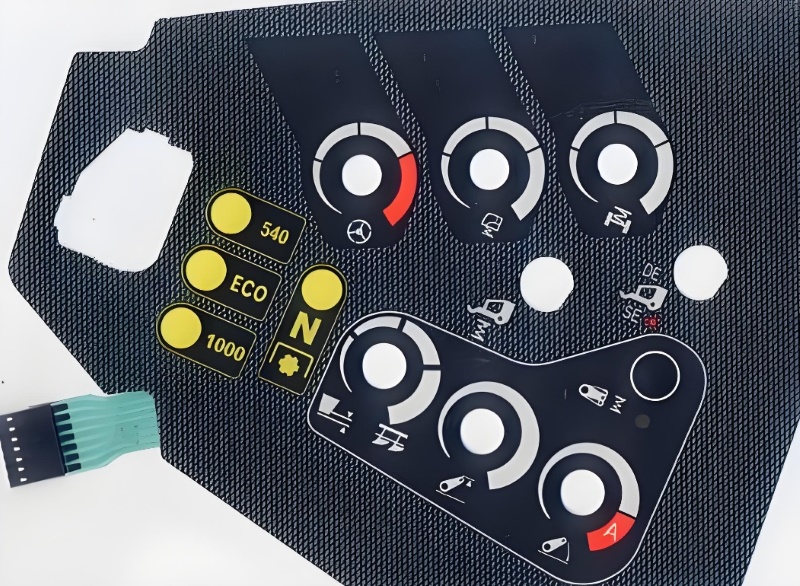Selecting the right membrane switch panel is essential for high-performance electronics that demand durability, reliability, and seamless operation. Membrane switches are integral to many devices, providing an interface that combines functionality and design. This guide offers insights into key selling points, pain points, application areas, product advantages, design features, and the value of membrane switch panels for high-performance electronics.

Key Selling Points of Membrane Switch Panels
Enhanced Durability: Membrane switches are designed for extensive use, made from materials like polyester and polycarbonate to withstand repeated pressing without losing functionality. This makes them ideal for applications requiring long-lasting performance.
Customizable Design: Membrane switch panels can be customized to include backlighting, embossing, and different tactile feedback options. These design features enhance usability, making the interface more intuitive and visually appealing.
Cost-Effective Solution: Compared to mechanical switches, membrane switch panels offer a more cost-effective solution without compromising quality. They are especially useful in high-volume production, where cost efficiency is essential.
Environmental Resistance: Many membrane switches are built to withstand environmental factors such as moisture, UV light, and extreme temperatures. This rugged design makes them suitable for both indoor and outdoor applications.
Addressing Common Pain Points with Membrane Switch Panels
Inconsistent Performance in Harsh Conditions: High-performance electronics often face challenging environments. Membrane switches are engineered to be dust-resistant, water-resistant, and, in some cases, even fully waterproof, which prevents performance degradation over time.
Complex Integration Requirements: Integrating a switch panel with the overall device design can be complex. Manufacturers of membrane switch panels provide customizable layouts and connector types, ensuring a seamless fit with various electronic components.
Limited Design Options: Traditional mechanical switches may be limited in design flexibility. Membrane switches overcome this with options for tactile feedback, backlit keys, and flexible designs that can match brand aesthetics and user needs.
Application Areas for Membrane Switch Panels
Membrane switch panels are widely used in industries that require precise, reliable, and user-friendly interfaces, including:
Medical Equipment: Membrane switches are ideal for medical devices that demand easy-to-clean, sterile surfaces. Their sealed design prevents contaminants from affecting performance, making them safe for use in clinical environments.
Industrial Controls: In manufacturing and industrial settings, membrane switches are used for machine control panels and equipment interfaces. Their durability and resistance to harsh environmental factors make them suitable for these rigorous applications.
Consumer Electronics: From household appliances to wearable devices, membrane switches provide a sleek, user-friendly interface that enhances the functionality of consumer electronics.
Automotive and Transportation: The automotive industry often requires backlit, weather-resistant switches for dashboards and control panels. Membrane switches fulfill these requirements with customizable, robust designs that enhance driver interaction and safety.
Advantages of Membrane Switch Panels
Compact and Lightweight: Membrane switches are slim, saving space within devices and allowing for a more compact design. This makes them suitable for modern, portable electronics where size and weight are critical considerations.
Ease of Cleaning and Maintenance: The sealed nature of membrane switch panels prevents dust, dirt, and liquids from penetrating the interface, making them easy to clean. This low-maintenance design is especially beneficial for medical and industrial applications where hygiene and durability are priorities.
Tactile Feedback for Improved User Experience: Many membrane switches offer tactile feedback, creating a satisfying feel when pressed. This improves the user experience, making the interface intuitive and responsive, especially in environments where visual cues might be limited.
Flexible Circuitry Options: Membrane switches often use flexible circuits, which allow for unique design configurations and support the integration of complex functions within limited space. This flexibility also enhances durability by reducing the risk of circuit damage due to constant bending or pressure.
Design Selling Points of Membrane Switch Panels
Backlighting and Custom Graphics: With options for LED backlighting, membrane switches improve usability in low-light conditions, adding a layer of functionality and aesthetics. Custom graphics, branding, and color options further enhance visual appeal and usability.
Embossing and Raised Keys: Membrane switches can incorporate embossed keys, which make it easy for users to feel the buttons without looking, adding to the user-friendly experience. Raised or textured keys help prevent errors in settings where accuracy is essential.
Touch Screen Integration: Modern membrane switch panels can be combined with touch screens, offering dual functionality in a single interface. This design maximizes device functionality without taking up additional space, enhancing the overall user experience.
Chemical Resistance: High-quality membrane switches are treated to resist various chemicals, making them suitable for use in laboratories, medical facilities, and industrial applications where exposure to cleaning agents or corrosive substances is common.
Value Proposition of Membrane Switch Panels for High-Performance Electronics
Membrane switch panels provide a high-value solution for manufacturers and end-users alike, combining versatility, durability, and customization. By choosing the right membrane switch, companies can enhance device reliability, improve user interaction, and reduce maintenance costs, adding significant value to the product.
These switch panels enable smooth operation and streamline device interfaces in various industries, from healthcare to industrial automation. For manufacturers, membrane switches offer a low-profile, cost-effective solution that can be easily integrated with different devices and adapted to specific requirements.
Investing in a high-quality membrane switch panel ensures that high-performance electronics meet industry standards and exceed user expectations. Whether it’s in a medical device requiring sterilization, an industrial machine interface that withstands tough environments, or a consumer gadget with an aesthetic, responsive touch, membrane switch panels are a crucial component that contributes to both functionality and longevity.
